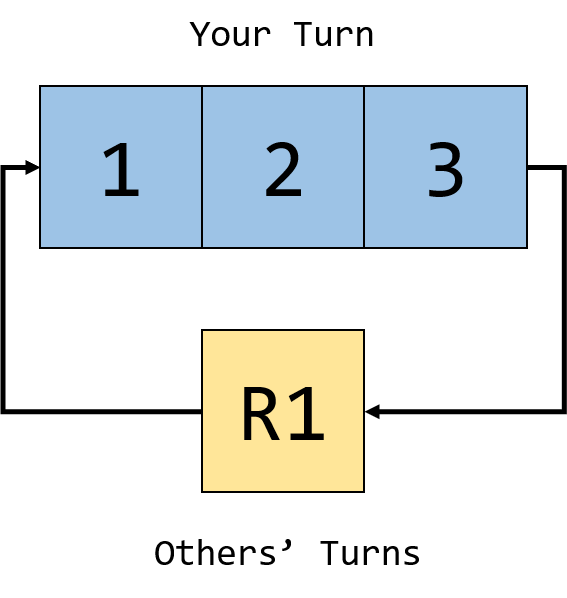

The Combat game state is the most detailed, chaotic, and mechanically complex part of gameplay. Combat is often a battle between two sides consisting of groups of combatants moving about quickly while attacking and defending each other. During combat, each combatant takes a turn in a predetermined order with a set number of actions divided into action frames.
Combat begins with each combatant rolling for initiative. The outcome of these rolls determine the turn order for the upcoming battle. During the fight, each combatant takes a turn which is made up of a number of frames in which that creature can take a variety of actions. After the active combatant uses all their available frames or passes their turn, the next combatant in initiative order becomes active. After the last combatant in the order has taken their turn, play returns to the first combatant, and repeats the cycle until combat ends. A complete cycle of turns is called a round. One round of combat occurs in approximately five seconds of game time.
Combat ends when there are no longer any active hostilities among party members, because all hostile creatures have been either killed or incapacitated, are no longer hostile, or the party has managed to separate from them in a way that any hostile parties are unable to continue pursuing their attack.
See the Combat Action List for a full list of actions that can be easily done in combat.

During your turn, you have a number of frames equal to your turn length. Most actions take one frame to complete, but some take as many as five. Circled numbers ① ② ③ next to an action's description indicate the number of frames needed to complete that action during combat. Some actions might specify a bonus if you devote more time to them.
Once you have used all of your turn's frames, your turn ends and the next combatant's turn starts.
It's possible for an action to span multiple rounds, though doing so carries a high risk of being interrupted. If you begin an action on your turn that takes up more frames than you have remaining in your turn, then the action will continue into your next turn and you will be preoccupied for the intervening round. The remaining needed frames will be taken up in your next turn, and the final result of your action won't take place until all the needed frames have passed.
If you are interrupted during this by anything that breaks your concentration, you automatically fail the action, but you regain any frames that hadn't yet passed at the time you were interrupted.
Actions that don't specify a number of frames take a great deal of time to complete, much more so than would be practical to attempt during a fight. But if you find yourself in a situation where you have no choice, you can attempt these actions during combat. Long actions during combat use the same time scale as effect durations: 1 minute = 10 rounds. If an action normally takes five minutes, during combat it takes 50 rounds. Your turn length does not affect this rule.
You will immediately fail the action if your concentration is broken. You are not preoccupied during a long action and so you may willingly abandon the attempt at any time by declaring a different action or reaction, but you still fail the long action as a result. If you need to do this, it's highly recommended to have your teammates cover you to keep you from being interrupted.
Main Page: Reactions
You can react quickly to attempted actions and attacks by your enemies, even during their turns. You have one reaction frame that can be used as a response to any action you can see coming. This frame is used if you decide to react, and is replenished at the start of your next turn. Unused reaction frames do not stack up.
Reaction frames can typically only be used to do something that relates to the action you're reacting to. For example, you typically could not react to an attack from one enemy by attacking a different enemy who is focused on someone else. This is largely up to the GM's judgment, and they may make exceptions under Rule Zero.
Reaction frames can't be used to start or continue an action that will extend into the next round, and can't be used at all if you ended your turn in the middle of a long action because you are preoccupied.
Main Page: Readied Actions
You can ready yourself for an action during your turn, in order to complete it as a free reaction when a certain condition is met.
When using a Readied Action, you spend the time to perform the action during your turn, but delay the action itself until the time is right. For instance, you might aim your crossbow and prepare to shoot at a monster when it exposes its weak spot.
Main Page: Opportunity
Some events might disrupt a combatant's moves, leaving an opportunity for an extra attack. For instance, a critical miss on an attack might cause the attacker to overbalance and stumble, leaving them open for retaliation. In this case, the attacker gives their target an opportunity action.
Opportunity frames cause the normal flow of combat to be paused while they resolve. They must be used immediately and can only be used to attack or otherwise interact with the combatant that gave opportunity.
Main Page: Surprise
If one side of a fight doesn't notice the other before combat begins because they are being stealthy, then any combatants that don't notice the threat are surprised and lose their first turn during the fight.